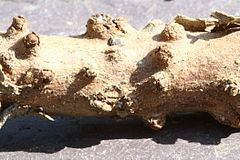Kingdom Fungi Order Xylariales Scientific name Lepteutypa Rank Genus | ||
 | ||
Similar Seiridium cardinale, Seiridium, Amphisphaeriaceae, Pestalotiopsis, Seimatosporium | ||
Lepteutypa is a genus of plant pathogens in the family Amphisphaeriaceae. First described by the Austrian mycologist Franz Petrak in 1923, the genus contains 10 species according to a 2008 estimate.
The genus Lepteutypa is teleomorphic (reproducing sexually) and the corresponding anamorphic name, used to describe the asexual form, is Seiridium (formerly Coryneum). For instance, the name Seiridium cupressi can still be used for the anamorphic form of that species, but now that it is known that a sexual stage exists, the name Lepteutypa cupressi should be preferred for the species as a whole. On the other hand, no sexual stage of species Seiridium cardinale is known, so that is its only name.
Seiridium cardinale and L. cupressi are important to gardeners and foresters as they cause the devastating Cyprus canker disease of Cupressus, Thuja, and related conifers in Northern Europe, America, Australia and New Zealand. S. cardinale is from California and was introduced to Europe around the 1930s, probably from infected nursery stock. A separate introduction affected the southern hemisphere.
